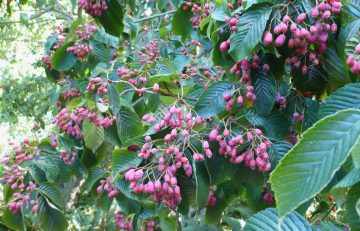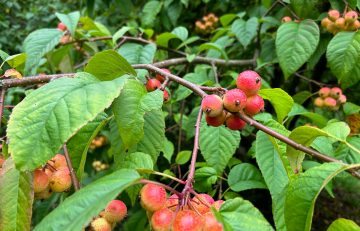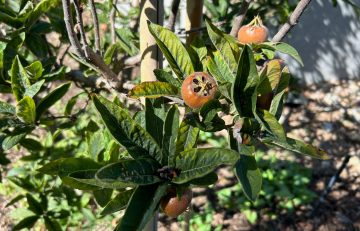
Cydonia oblonga ‘Champion’
Apples, to nobody’s surprise, are among the most popular of fruits. The genus to which apples belong—Malus—is well known in horticulture, both for the orchard apple (Malus domestica), of which there are a staggering seventy-five hundred known cultivars, and the crab apples (or crabs), whose foliage, flowers and fruits are often remarkably ornamental. Among the species, only the orchard apple and its progenitor, the Asian wild apple (Malus sieversii) from southern Kazakhstan, have notably large fruits, evolved to attract sizable mammals, such as horses or camels, to disperse their seeds. The crabs, which include essentially all other Malus species, have more diminutive fruits that are attractive to smaller animals, particularly birds. Apple and crab apple flowers are usually pink in bud, opening white, the petals detaching after fertilization, leaving a ring of five triangular green sepals atop the developing fruit.
The fruit of the apple is known as a pome. The pome hardly needs description. Everyone—except, perhaps those who have only ever eaten apples that were already peeled, cored and sliced—would recognize its distinctive features: the five-chambered ovary (the “core”) at the centre of the fruit (each chamber containing seeds), the flesh surrounding the hard and tough, “cartilaginous” ovary walls, and the waxy protective skin. The characteristic remnants of the flower (the sepals and spent stamens, primarily) are located at the base of the fruit. From a developmental point of view, and as noted above, the bottom of the pome is actually the top, in that it is derived from the ovary and its surrounding tissues, which are located below the flower’s petals and sepals.
Our apple collection is concentrated in the Food Garden. There, the trees are trained as espaliers, a compact, usually two-dimensional style of training that is highly ornamental and both exerts a degree of size control and improves fruit-bearing potential. In all, there are nineteen different apple cultivars and two pears along the path on the south side of the Food Garden wall. According to our Food Garden horticulturist, Linda Layne, the apple cultivars ‘Liberty’ and ‘Haralson’ were this year’s standouts. Both appeared to bear well and avoid the usual coddling moth and apple maggot problems to which apples are locally prone. Visitors can admire the espaliers, but should know that all of the apple crops ripened early this year and the last of them were harvested in late September.
Elsewhere in the garden are eight different wild crab apples. Our locally native Malus fusca (Pacific crab—one of only two wild Malus species in North America) is well represented—and much appreciated by smaller birds for its twiggy shelter and small, ovoid purplish fruits—along the fence line in the Garry Oak Meadow and Pacific Slope gardens and in the BC Rainforest Garden. Malus prattii (where Stearn Trail meets Siebold Trail in the David C. Lam Asian Garden) has lovely, yellow-turning-orange-red pomes and ample, surprisingly unspoiled leaves, even now. Most Malus species and cultivars are plagued by leaf diseases, but Pratt’s crab and Malus yunnanensis, another southwestern Chinese species, generally escape the normal ravages of apple scab and powdery mildew that disfigure most apples and crabs. The pomes of the Yunnan crab are a similar size to Pratt’s, but mostly change from green to golden brown when ripe. The most visible examples of M. yunnanensis are on Fortune Trail, and at the edge of Wharton Glade near Ludlow Trail.
Pomes are not limited to apples and crabs. Many familiar edibles and ornamentals have pome fruits and are thus, close Malus relatives. These include Amelanchier (saskatoon and service berry), Aria (whitebeam), Aronia (chokeberry), Chaenomeles (Japanese quince), Cydonia (quince), Mespilus (medlar), Pyrus (pear), Sorbus (mountain ash) and many others. With respect to edible pomes, the Food Garden is where you’ll see the European quince cultivar, Cydonia oblonga ‘Champion’ (in the Pavilion bed above and to the west of the main Food Garden) and the medlar, Mespilus germanica ‘Large Russian’ (on the south side of the wall, facing the Pacific Slope Garden). Quince pomes are often very large, and coated in a vestiture of soft, floccose hairs. The flocking is readily removed when the fruits are handled. Medlars have strange looking, brown, flattened pomes, with the flower end of the fruit gaping, and the persisting sepals lengthening with the expanding fruit. Edibility for both quince and medlar depends on bletting, a natural process whereby cold-temperature enzymes convert the starchy flesh to a sweet pulp.
Three whitebeams are worthy of note: Aria yuana (Yunnan whitebeam) has lozenge-shaped fruit that are vermillion-red and borne in prodigious quantity. The tree is clearly visible (and impossible to miss) from Upper Asian Way close to the Garden’s entrance. These fruits are also edible, though they need only to be ripe to soften, and they are full of gritty stone cells. A little further along Upper Asian Way just past where Staunton Trail crosses, is an excellent example of Aria pallescens (pale-leaf whitebeam), which bears small yellow globose pomes that burnish red where exposed to the sun (like tiny apples). From this location looking north, a broad-crowned Hemsley’s whitebeam crowds the view (the tree is just north of Maries Trail). This uncommon tree really stands out, with its large silver-backed leaves and russet-spotted yellow pomes. Another equally impressive specimen is located close to where Lower Asian Way meets Campbell Trail.
Located near the old bee hive area (we no longer keep European honeybees on site, as they compete with native bees) is an example of the black chokeberry, Aronia melanocarpa, an eastern North American species noted for the exceptionally high level of ascorbic acid (vitamin C) in its pomes. When not absolutely ripe, they are inedibly astringent, hence the common name, chokeberry. Curiously, the black chokeberry tends to bear its heaviest fruit crops in alternating years. Though the pomes of this species look more like those of a chokecherry (Prunus virginiana) than an apple, the Malus kinship is revealed by the presence of the tell-tale sepal remnants at the bottom (top) of the fruit.
- Aria hemsleyi
- Aria pallescens
- Aria yuana
- Aronia melanocarpa
- Cydonia oblonga ‘Champion’
- Malus domestica
- Malus fusca
- Malus prattii
- Mespilus germanica ‘Large Russian’
Submitted by: Douglas Justice, Associate Director, Horticulture and Collections










I love these columns!